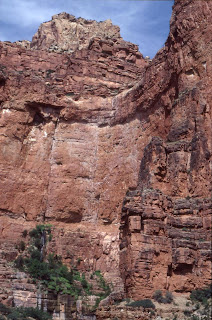8/9/1869
Glen Campbell: Gentle On My Mind
And now the scenery is on a grand scale. The walls of the canyon, 2500 feet high, are of marble of many beautiful colors, and often polished below by the waves, or far up the sides, where showers have washed the sands over the cliffs.
At one place I have a walk, for more than a mile, on a marble pavement, all polished and fretted with strange devices, and embossed in a thousand fantastic patterns. Through a cleft in the wall the sun shines on this pavement, which gleams in iridescent beauty.
I pass up into the cleft. It is very narrow, with a succession of pools standing at higher levels as I go back. The water in these pools
is clear and cool, coming down from springs. Then I return to the pavement, which is but a terrace or bench, over which the river runs at its flood, but left bare at present. Along the pavement, in many places, are basins of clear water, in strange contrast to the red mud of the river. At length
I come to the end of this marble terrace, and take again to the boat.
Riding down a short distance,
a beautiful view is presented.
The river turns sharply to the east, and seems enclosed by a wall, set with a million brilliant gems.
What can it mean?
Every eye is engaged, everyone wonders. On coming nearer, we find fountains bursting
from the rock, high overhead, and the spray in the sunshine forms the gems which bedeck the wall. The rocks below the fountain
are covered with mosses,
and ferns, and many beautiful
flowering plants.
We pass through many side canyons today that are dark, gloomy passages back into the heart of the rocks that form the plateau through which this
canyon is cut.
It rains again this afternoon. Scarcely do the first drops fall when little rills run down the walls. As the storm comes on the little rills increase in size until great streams are formed. Although the walls of the canyon are chiefly limestone, the adjacent
country is of red sandstone; and now the waters, loaded with these sands, come down in rivers of bright red mud, leaping over the walls in innumerable cascades.
It is plain now how these walls are polished in many places.
At last the storm ceases and we go on. We have cut through the sandstones and limestones met in the upper part of the canyon, and through one great bed of marble a thousand feet in thickness.
In this, great numbers of caves are hollowed out, and carvings are seen, which suggest architectural forms, though on a scale so grand that architectural terms belittle them.
It is a peculiar feature of these walls that many projections are
set into the river, as if the wall was buttressed for support. The walls themselves are half a mile high, and these buttresses are on a corresponding scale, jutting into the river scores of feet. In the recesses between these projections there are quiet bays, except at the foot of a rapid, when there are dancing eddies or whirlpools. Sometimes these alcoves have caves at the back, giving them the appearance of great depth. Then other caves are seen above, forming vast, dome-shaped chambers. The walls, and buttresses, and chambers are
all of marble.
The river is now quiet; the canyon wider. Above, when the river is at its flood, the waters gorge up, so that the difference between high and low water mark is often fifty or even seventy feet; but here, high water mark is not more than twenty feet above the present stage of the river. Sometimes there is a narrow flood-plain between the water and the wall.
--John Wesley Powell
journal entry for August 9, 1869
Molly Tuttle: Gentle On My Mind









<< Home